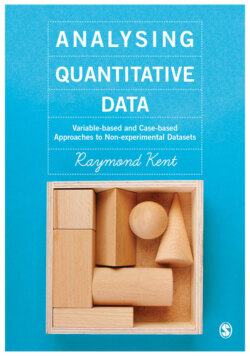Читать книгу Analysing Quantitative Data - Raymond A Kent - Страница 24
На сайте Литреса книга снята с продажи.
The implications of this chapter for the alcohol marketing dataset
ОглавлениеThe alcohol marketing study is based on the construction of quantitative data using a combination of interviewer-completed and self-completed (but personally delivered) questionnaires in a cross-sectional survey research design. The resulting dataset is far from being error free and there are many ambiguities. The researchers explain that they sent an information pack ‘to the homes of all second year (12–14 years) pupils attending schools in three local authority areas in the west of Scotland’ (Gordon et al., 2010a). This, they say, ‘generated a sample of 920 respondents’. Although they call this set of cases a ‘sample’, they do not mention what population the sample is meant to be a sample of. They do not say how many packs were sent out, so there is no idea of what the response rate was. Accordingly, it is probably safest to regard the 920 cases as an incomplete census of all the pupils in the selected schools. It is almost certainly not a random sample, or indeed not really a sample of any kind. The date when these packs were sent is not stated, but from other sources it was probably between October 2006 and March 2007. The authors do not discuss why the 12–14-year age group is the appropriate one to choose for this research or why the west of Scotland was chosen for its location.
In the original dataset, over 1,600 variables were entered for each of the 920 cases. A lot of variables were created because, for example, each brand of alcohol drunk last time was listed as either drunk or not drunk and recorded as a separate binary variable. For this text, two datasets were created from the original, one for a selection of 61 properties recorded as variables and another for a selection of those properties recorded as set memberships. Table 1.1, presented earlier in this chapter, lists the variables, the range of values used for each variable and the type of measure. Table 1.2 lists the set memberships, whether they are crisp or fuzzy and whether they are being used as conditions or outcomes.
Table 1.2
The properties of the 920 cases are a mixture of demographic, behavioural and cognitive characteristics which play a range of different roles as descriptors, as potentially causal factors or as outcomes. All 61 properties may be used as descriptors and some, like drink status, may be seen either as an outcome or as a potentially causal factor. Many of the properties are measured directly, for example ‘Read a newspaper in the last seven days’. Some, like total importance of brands, are derived. Social class is measured indirectly from the occupation of the chief income earner (CIE) in the household.
Potentially there are many sources of error in the dataset, particularly from non-response (we do not know how many households refused their consent) and from response error (there is considerable scope for exaggeration or minimization of drinking behaviours). Some errors, for example from poor questionnaire design, can be addressed through recoding or transforming properties in ways that are considered in Chapter 2.
